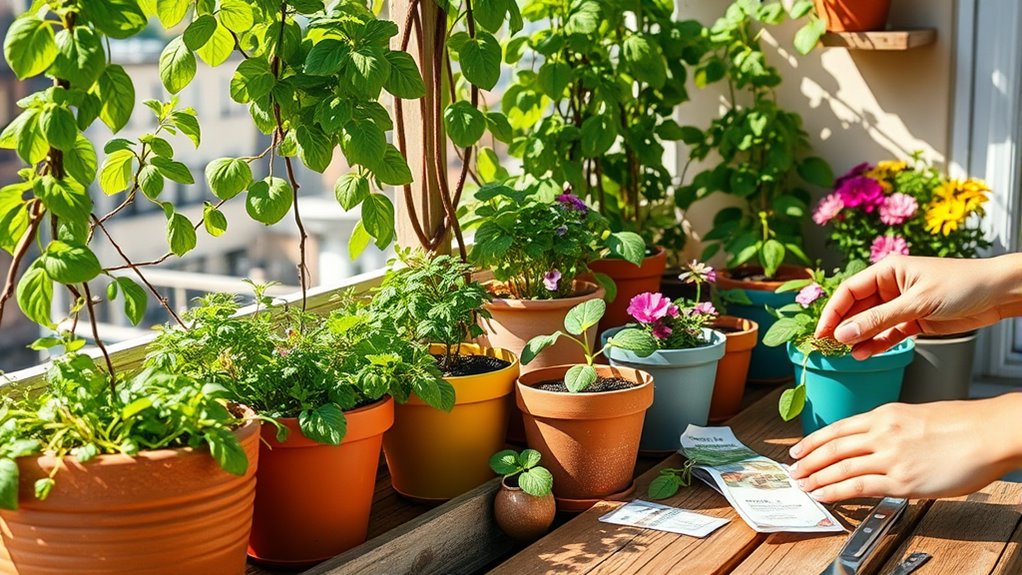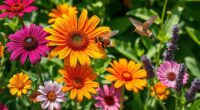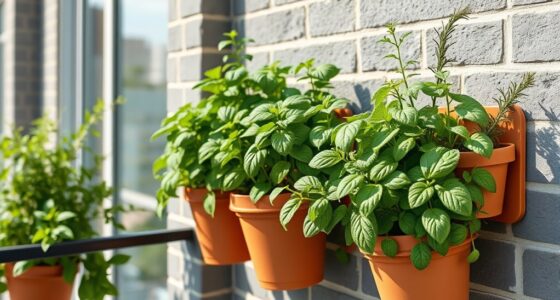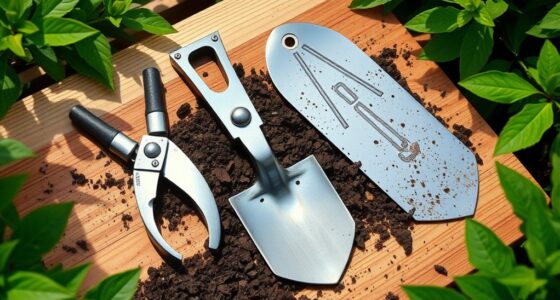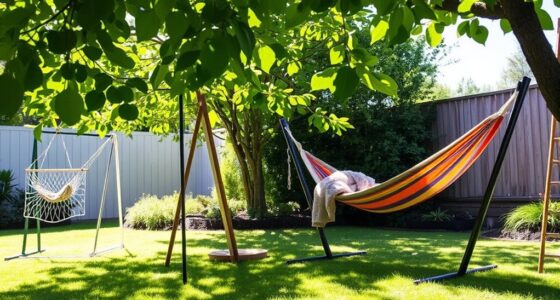Container gardening is perfect for beginners looking to grow plants indoors or outdoors. Start by choosing the right containers with drainage holes and match them to your plants’ needs. Use quality soil, water consistently, and select plants suited for your light conditions. Keep pests in check and arrange your garden thoughtfully. As you develop your skills, you’ll discover more tips for success—keep exploring to turn your container garden into a thriving space.
Key Takeaways
- Choose the right containers with drainage holes, appropriate size, and material to support healthy plant growth.
- Use high-quality potting soil mixed with organic matter and regularly test soil pH and moisture levels.
- Select plants suited for your climate, considering light needs, height, and visual appeal for a cohesive garden.
- Develop a consistent watering routine, ensure proper drainage, and monitor plants for pests and diseases.
- Incorporate organic fertilizers and pest control methods to maintain healthy, thriving container plants.
Choosing the Right Containers for Your Plants
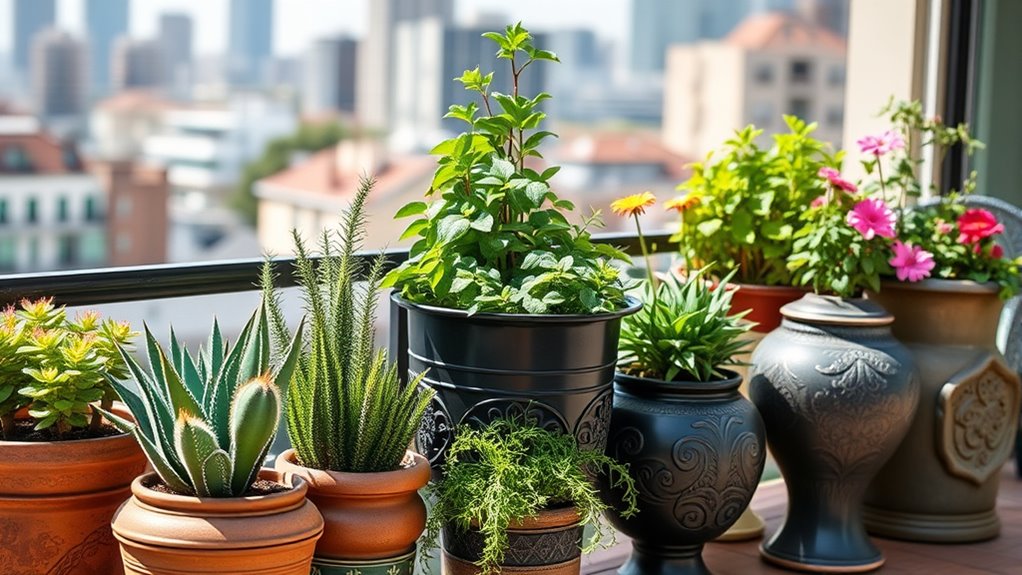
When selecting containers for your plants, it’s essential to take into account both their size and material to guarantee healthy growth. The container design should accommodate your plant’s root system, ensuring enough space for development without overcrowding. For example, larger plants need bigger pots to prevent root bound issues, while smaller plants thrive in more modest containers. Material matters too; terra cotta promotes good airflow but dries out quickly, whereas plastic retains moisture longer. Your plant selection influences container choice as well—succulents prefer well-draining options, while ferns need containers that hold more moisture. Choose containers with drainage holes to avoid waterlogging. Additionally, considering the contrast ratio of your containers can help optimize light reflection and overall visual appeal in your garden setup. By matching container design and material to your plant selection, you set a solid foundation for a thriving container garden.
Selecting the Best Soil for Container Gardens
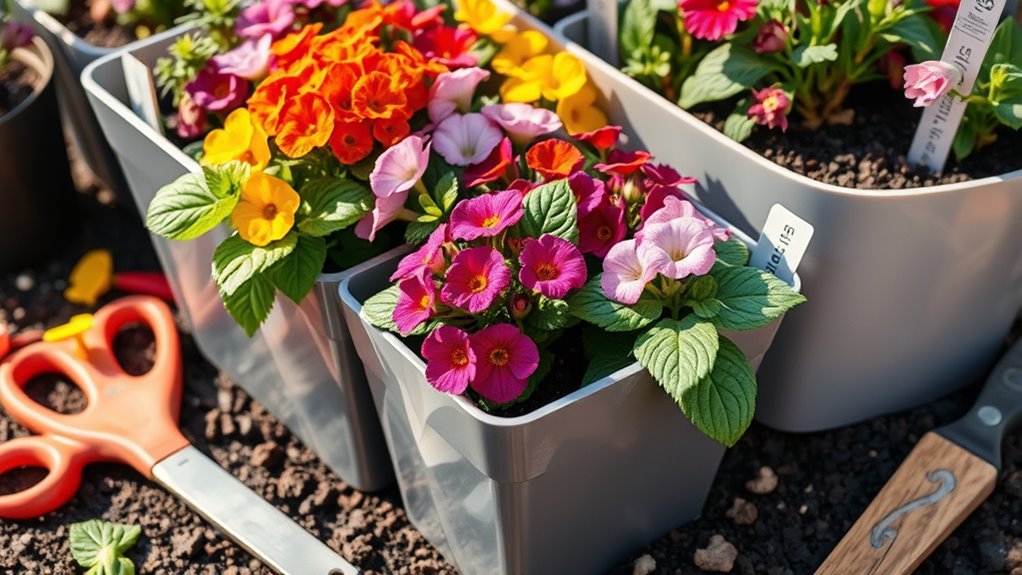
Choosing the right soil is essential for your container garden’s success because it directly impacts plant health and growth. Start with a high-quality potting mix designed for containers, as it provides proper drainage and aeration. To improve soil fertility, incorporate soil amendments like compost or organic matter, which supply essential nutrients. Regular pH testing helps ensure your soil stays within the optimal range for your plants, usually between 6.0 and 7.0. If the pH is off, you can adjust it using lime or sulfur, depending on whether you need to raise or lower the pH. Avoid using garden soil alone, as it can be too dense and may contain pests or diseases. Proper soil selection and amendments create a healthy environment where your plants can thrive. Additionally, understanding soil composition can help you make more informed decisions about amendments and plant compatibility.
Picking the Perfect Plants for Your Space
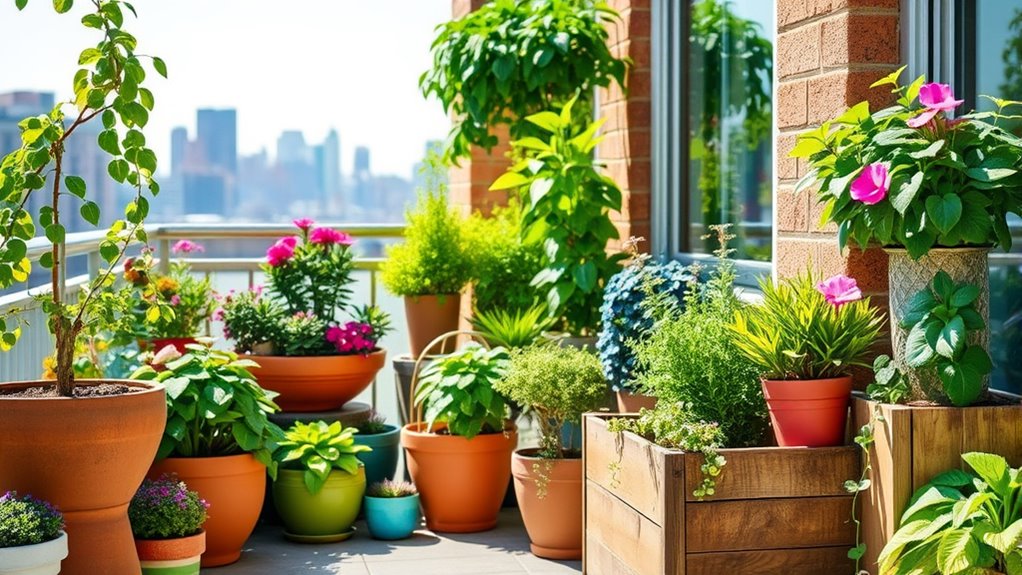
Are you selecting plants that will thrive in your specific space? To do so, consider plant height and container size. Choosing the right plants guarantees they grow healthily and look beautiful.
Here are four tips to help you pick the perfect plants:
- Pick plants with a plant height that complements your container and space, avoiding overcrowding.
- Match container size to the mature size of the plant to give roots ample room to grow.
- Choose varieties suited for your climate to prevent frustration and disappointment.
- Opt for plants with vibrant colors or interesting textures to create a lively, inviting atmosphere.
Understanding Light Requirements for Different Plants
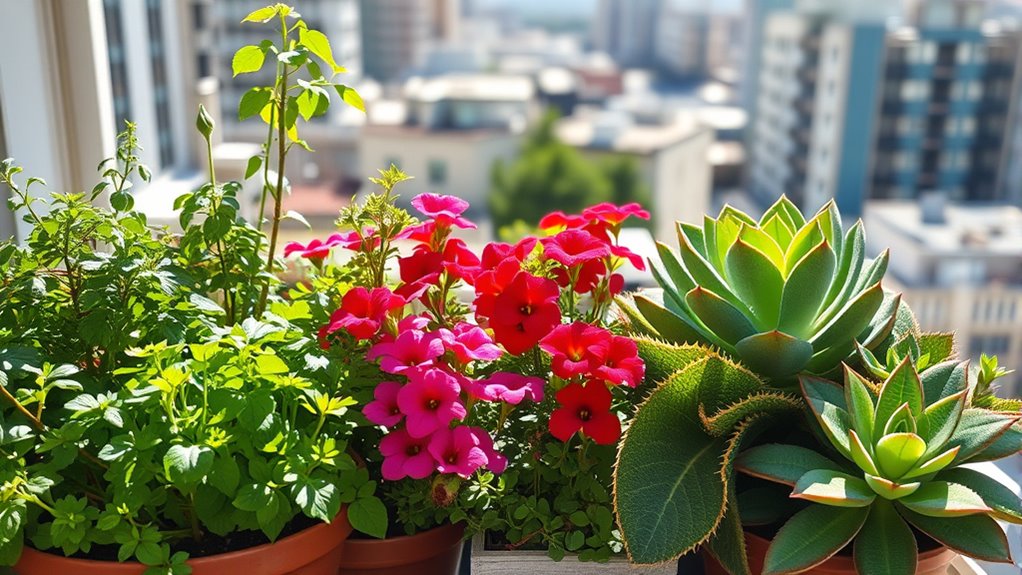
Different plants have specific sunlight needs, so it’s important to know whether they thrive in full sun, partial shade, or full shade. Understanding shade tolerance levels helps you choose the right spot for each plant, ensuring they grow healthy and strong. Keep in mind that light intensity can affect growth rates and flowering, so adjusting placement accordingly makes a big difference. For those interested in optimizing plant performance, exploring light tuning techniques can help tailor the environment to each plant’s needs.
Sunlight Needs Variations
Have you ever wondered why some plants thrive in direct sunlight while others flourish in shade? The answer lies in sunlight variation. Different plants have unique light needs, so understanding this helps you choose the right spot for each container. For example, some plants require full sun, while others do well in partial shade. Indoor lighting also plays a role; you can supplement natural light with grow lights if needed. Additionally, solar panels for camping can provide supplemental energy solutions, which is useful for indoor grow lights or other gardening equipment. Consider these key points:
- Bright, direct sunlight energizes sun-loving plants.
- Partial shade suits plants sensitive to intense light.
- Indoor lighting can mimic outdoor conditions.
- Monitoring sunlight variation helps prevent plant stress and promotes healthy growth.
Matching light needs ensures your container garden thrives, whether outdoors or indoors.
Shade Tolerance Levels
Understanding shade tolerance levels is essential for selecting the right plants for your container garden. Different plants have varying shade adaptation, which determines how well they thrive in low-light conditions. Recognizing a plant’s light sensitivity helps you match it to your space’s light availability, ensuring healthier growth. Some plants are highly shade tolerant and do well in darker corners, while others prefer partial or full sun. Pay attention to labels and plant descriptions that specify their shade needs. When you choose plants suited to your garden’s light levels, you reduce the risk of poor growth or disease. Additionally, understanding tiny house size restrictions can help you select appropriately scaled plants for your container setup. Properly evaluating light sensitivity allows you to create a balanced, thriving container garden that flourishes regardless of your space’s lighting conditions.
Light Intensity Effects
How much light a plant needs directly impacts its growth and health in your container garden. Understanding light spectrum and sunlight duration helps you choose the right spot for each plant. For example, some thrive with full sun, while others prefer partial shade. Keep these points in mind:
- Bright, direct sunlight energizes sun-loving plants and boosts flowering.
- Extended sunlight duration enhances growth but can cause leaf scorch if intense.
- A full spectrum of light supports photosynthesis, essential for healthy foliage.
- Insufficient light leads to leggy, weak plants, making your effort fruitless.
- Being aware of performance metrics can help you optimize your garden’s light conditions for better plant health.
Watering Techniques and Tips for Healthy Growth
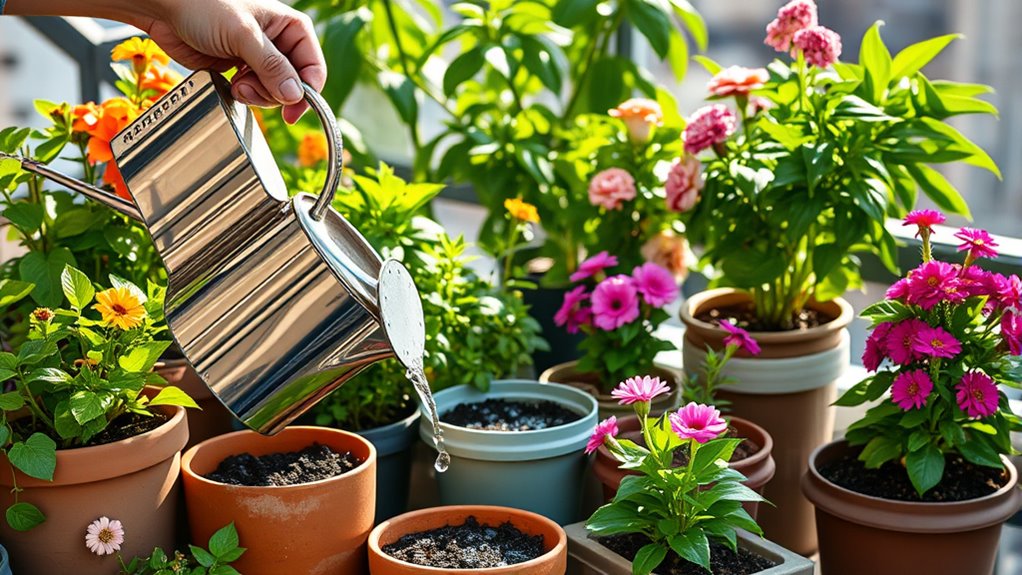
To keep your container plants healthy, you need a consistent watering schedule that matches their needs. Guarantee proper drainage so excess water flows out easily, preventing root rot. Regularly check the soil moisture to avoid over- or under-watering and promote vigorous growth. Incorporating watering techniques like deep watering and mulching can further improve plant health.
Consistent Watering Schedule
Ever wonder why some container gardens thrive while others struggle? The key is maintaining a consistent watering schedule. When you stick to a regular watering frequency, your plants develop stable moisture levels, reducing stress and promoting healthy growth. Here are four tips to help you stay on track:
- Monitor moisture levels daily to avoid over- or underwatering.
- Water early in the morning for ideal absorption.
- Adjust watering based on weather—more in heat, less in cooler periods.
- Use a finger test—stick your finger an inch into the soil to check moisture.
- Remember that watering techniques and tips are crucial for healthy growth.
Proper Drainage Practices
Maintaining proper drainage is essential for healthy container gardens, as even the best watering schedule can be undermined by poor drainage practices. To improve soil aeration, choose containers with drainage holes and avoid overfilling them. Elevate your pots slightly off the ground to prevent water from pooling and promote airflow. Container insulation also plays a role; insulate your pots during cold weather to prevent soil from staying too wet or freezing, which can damage roots. Be mindful not to let excess water sit in the bottom, as this can lead to root rot. Regularly check that water drains freely and avoid compacting the soil, which hampers aeration. Proper drainage ensures roots receive oxygen and stay healthy, supporting robust plant growth.
Monitoring Soil Moisture
Monitoring soil moisture is essential for ensuring your container plants thrive. Keeping an eye on soil levels helps prevent overwatering and dehydration, both of which can harm your plants. Using soil sensors or moisture meters makes this task easier and more accurate. Here are four ways to stay on top of moisture levels:
- Check soil moisture daily—know exactly when to water.
- Use moisture meters for quick, reliable readings.
- Insert soil sensors to monitor moisture levels continuously.
- Observe plant signals like wilting or yellowing leaves as natural indicators.
- Regularly assessing soil moisture aligns with energy efficiency practices by preventing unnecessary watering and conserving resources.
Fertilizing Your Container Garden
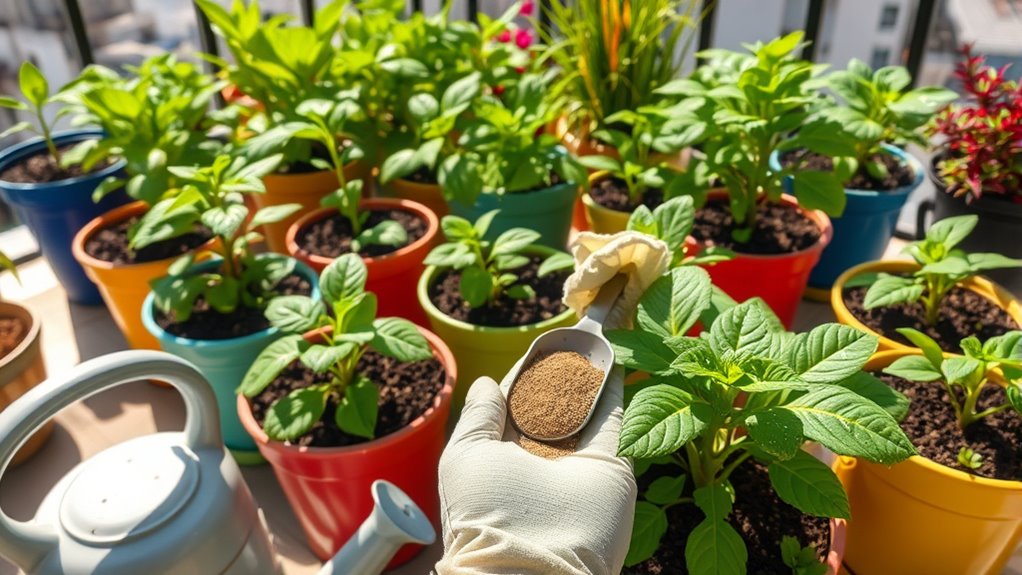
Fertilizing your container garden is essential for healthy, vigorous plants, especially since nutrients can quickly become depleted in confined soil. To guarantee optimal growth, choose the right container selection that allows proper drainage and space for roots to develop. Incorporate companion planting strategies, as some plants naturally enhance each other’s nutrient uptake, reducing the need for excessive fertilization. Use a balanced, water-soluble fertilizer every few weeks, following package instructions for your specific plants. Organic options like compost tea or fish emulsion also work well and improve soil health. Remember, over-fertilizing can harm your plants, so monitor their growth and adjust feeding accordingly. Proper fertilization keeps your container garden lush, productive, and thriving throughout the season. Additionally, selecting unique and wicked planters can add artistic elements to your garden while promoting healthy plant growth.
Arranging and Planning Your Garden Layout

Planning your container garden layout is a crucial step to guarantee your plants thrive and look attractive. Consider container size carefully—larger containers provide more room for roots and healthier growth, while smaller ones add charm and versatility. Think about design aesthetics: arrange your plants to create visual harmony, balancing colors, textures, and heights.
Design your container garden with thoughtful sizes, appealing arrangements, and balanced plant groupings for vibrant, healthy growth.
Here’s how to approach it:
- Visualize your space and choose containers that complement it.
- Mix tall and trailing plants for variety and movement.
- Group similar plants for easier care and cohesive look.
- Make certain each container has enough space for growth, avoiding overcrowding.
Managing Pests and Diseases in Container Gardening

You need to recognize common pests like aphids and spider mites to keep your container garden healthy. Identifying these invaders early helps you choose effective, organic control methods. By staying vigilant, you can prevent diseases and maintain thriving, pest-free plants.
Common Pest Identification
Ever wonder how to quickly spot pests before they cause serious damage? Recognizing common pests is key to effective pest identification in your container garden. Look for signs like chewed leaves, sticky residue, or discolored spots—these clues reveal pest presence early. Here are four common pests to watch out for:
- Aphids—tiny, green or black insects clustered on new growth.
- Spider mites—minute, reddish or yellowish pests that leave fine webbing.
- Whiteflies—small, white flying insects buzzing around plants.
- Fungus gnats—small black flies hovering near soil surfaces.
Early detection of these pests can save your plants from decline. Keep a close eye on your containers, and act swiftly at the first signs of infestation to keep your garden healthy and thriving.
Organic Disease Control
Wondering how to keep your container garden healthy without relying on harsh chemicals? Organic disease control offers effective solutions that protect your plants naturally. One key approach is utilizing composting benefits, which enrich your soil with beneficial microbes that help fight off diseases. Regularly inspect your plants for signs of pests and diseases, removing affected leaves immediately. To prevent outbreaks, practice organic pest control methods like introducing beneficial insects or using neem oil. Avoid chemical treatments that can harm your plants and the environment. Maintaining good airflow and proper watering also reduces disease risk. By combining these strategies, you create a resilient garden that stays healthy and productive, all while avoiding synthetic chemicals and supporting eco-friendly gardening practices.
Seasonal Care and Maintenance
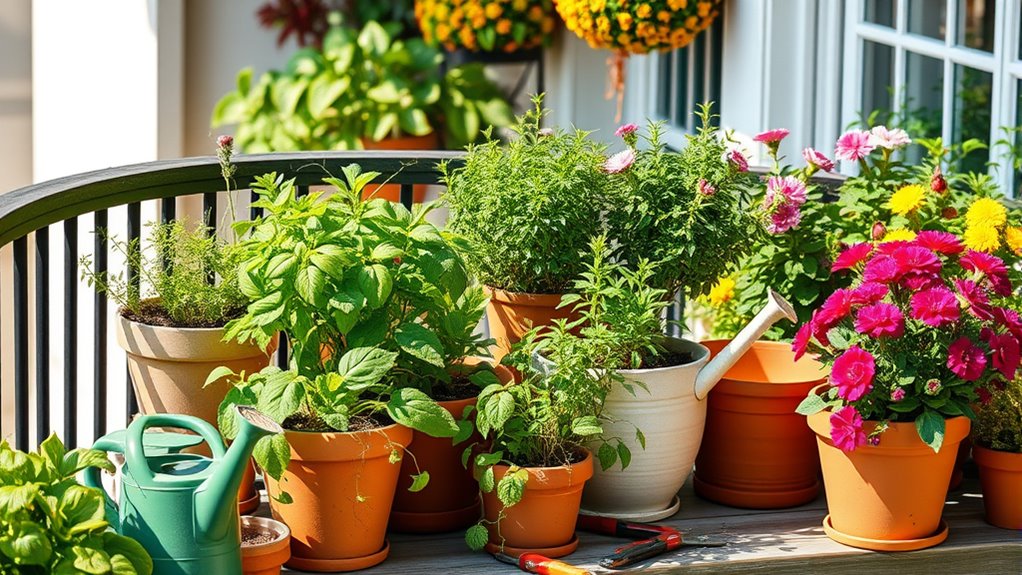
Seasonal care and maintenance are essential to keeping your container gardens thriving throughout the year. Proper attention guarantees your plants stay healthy, vibrant, and productive. To do this effectively:
- Adjust container design to match the season, using protective coverings or selecting plants suited for changing weather.
- Modify watering methods—water more frequently during hot months and reduce in cooler seasons to prevent overwatering.
- Protect your plants from frost by moving containers to sheltered spots or wrapping them with mulch.
- Regularly check for pests and diseases to nip problems in the bud before they spread. Staying attentive through each season keeps your garden lush and rewarding.
Tips for Successful Harvesting and Enjoying Your Garden
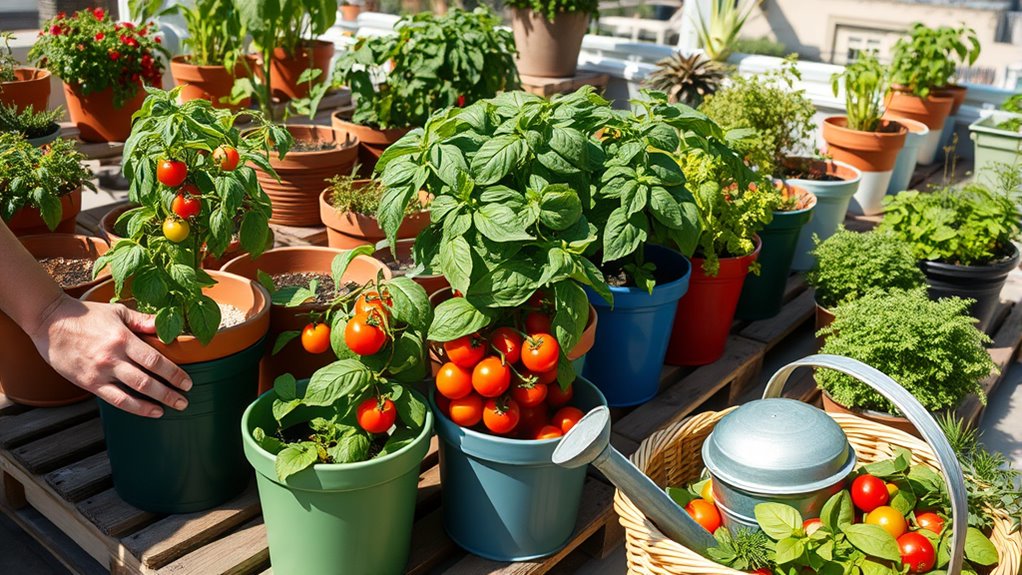
To enjoy the full flavor and beauty of your garden’s bounty, timing your harvest correctly is essential. Pick fruits and vegetables when they’re ripe—check color, size, and firmness. Use quality container gardening tools like pruning shears and trowels to make harvesting easier and cleaner. After harvesting, consider composting techniques to recycle plant scraps and enrich your soil for next season. Proper harvesting also prevents overripeness and plant disease. Keep a harvest schedule to track ripening times.
| Task | Tip |
|---|---|
| When to harvest | Fruits and vegetables are ripe when fully developed and color is vivid. |
| Tools to use | Use sharp, clean container gardening tools for neat cuts. |
| Post-harvest handling | Gently clean produce and store appropriately. |
| Composting after harvest | Add plant waste to compost to boost soil health. |
Frequently Asked Questions
How Do I Prevent My Containers From Tipping Over?
To prevent your containers from tipping over, focus on plant stabilization and strategic container placement. Use heavier pots or add stones at the bottom for extra weight. Position taller plants towards the center or back, and keep containers on stable, flat surfaces. Secure lightweight containers with stakes or anchors if needed. By stabilizing your plants and choosing secure spots, you’ll keep your containers steady and prevent accidental tipping.
Can I Grow Vegetables in Small Balcony Containers?
Yes, you can grow vegetables in small balcony containers, but you should start with compact, container-friendly varieties. Use quality urban soil mixed with compost for nutrients and guarantee proper drainage. Keep an eye out for container pests, which can be common in small spaces. Regularly inspect your plants, and if pests appear, treat them promptly to prevent damage. This approach helps your balcony garden thrive despite limited space.
What Are Eco-Friendly Options for Container Gardening?
Think of your garden as a living symphony, where eco-friendly choices compose harmony. You can use composting methods to turn kitchen scraps into rich soil, reducing waste. Opt for organic fertilizers that nurture plants naturally, avoiding chemicals. These sustainable options sustain your garden’s liveliness, much like a maestro guides an orchestra. Embrace these eco-friendly practices to create a thriving, environmentally conscious container garden that benefits both you and the planet.
How Do I Winterize My Container Plants?
To winterize your container plants, you need to focus on winter protection and container insulation. Move sensitive plants indoors or to a sheltered spot, and wrap containers with insulating materials like bubble wrap or burlap to prevent freezing. Elevate pots off cold ground to avoid frost damage. Water plants sparingly during winter, and consider using mulch or straw around the base for added insulation. This helps your plants survive cold temperatures and stay healthy.
Is It Possible to Grow Plants Indoors With Limited Sunlight?
Did you know that over 70% of people grow plants indoors? You can definitely grow plants indoors with limited sunlight by choosing low light plant choices like pothos or snake plants. Indoor herb gardening becomes easier too, even with minimal natural light. Use grow lights or place your plants near windows, and you’ll enjoy fresh herbs and greenery all year round. Don’t let limited sunlight stop your indoor gardening dreams!
Conclusion
As you embrace container gardening, you’ll find that the right choices often come together unexpectedly—like discovering a perfect plant in a spot you hadn’t considered. With patience and attention, you’ll enjoy the simple pleasure of watching your garden thrive, turning everyday moments into a rewarding coincidence of growth and beauty. Stay curious and adaptable, and you’ll soon realize that each small success weaves seamlessly into a lush, vibrant oasis tailored just for you.
